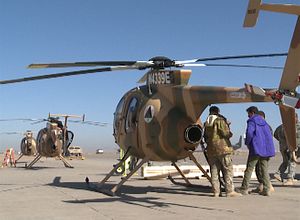With more than 4,000 soldiers and police officers killed and over 8,000 wounded, the Afghan National Defense and Security Forces (ANDSF) are in the middle of one of the bloodiest fighting seasons Afghanistan has seen to date.
One reason for the high casualty rates of government forces is the perennial lack of close air-support by the Afghan Air Force (AAF) during ANDSF combat operations. The commander of U.S. Forces in Afghanistan, Gen. John F. Campbell, testified in March that aviation will remain one of the most critical ANDSF capability gaps during the 2015 fighting season.
His statement was reiterated by a June 2015 report by the U.S. Department of Defense that noted:
Overall, the ANDSF’s most critical gaps remain in aviation, intelligence, and special operations, all linked to the ANDSF’s targeting capability. These gaps will endure for some time, even with the addition of key enablers.
According to IHS Jane’s Defense Weekly, the AAF is now converting five unarmed MD 530F “Little Bird” aircraft into “Cayuse Warrior” light attack gunships bringing up the AAF light attack helicopter fleet to 17. The five MD 530F will be retrofitted with the Enhanced Mission Equipment Package (EMEP) at a facility in the United States and return to Afghanistan for the 2016 fighting season.
IHS Jane’s Defense Weekly elaborates:
The EMEP is a development of the Mission Equipment Package (MEP) which the helicopters were initially delivered with. While the MEP comprises twin FN Herstal 12.7 mm Heavy Machine Gun Pods (HMPs), the Rhode & Schwarz M3AR tactical radio communications system, the Robertson Fuel System, and Kinetic Defense ballistic armor panels for the two-person crew, the EMEP adds to this with the M260 air-to-surface rocket launcher.
An EMEP-equipped MD 530F will have an HMP carried on one side of the helicopter, and a seven-tube M260 launcher on the other. The 70 mm rockets will increase the helicopter’s stand-off range from about 1,900 m with the machine guns to about 8,000 m.
The principal reason for the retrofitting is delays in the delivery of 20 Embraer EMB 314 Super Tucanos, aka A-29s, fixed-wing aircraft specifically designed for counter-insurgency operations. The first A-29 is slated to enter service at the end of 2015. However, as I noted in a previous piece (See: “When Will the Afghan Air Force Be Ready to Fight the Taliban?”), only a handful of aircraft will arrive in 2016, with the majority being delivered in 2017 and 2018. “In hindsight, I wish we would’ve started that years ago,” Gen. John F. Campbell testified back in March, yet “we are where we are.” “Quite frankly, we can’t get it out there quick enough for them,” he stated when talking about the controversial aircraft procurement process.
A number of MD-530F Cayuse Warrior helicopters were recently involved in a combat mission south of Jalalabad. “This operation marks the first successful employment of armed MD-530 helicopters in support of Afghan national defense and security forces as they continue clearing the districts of Khogyani, Sherzad and Hisarak of insurgents,” according to NATO sources.
The AAF is also using Mi-24/35 attack helicopters but they are rarely operational. An AAF Russian-made Mi-17 crashed last week killing 17 people on board.

































